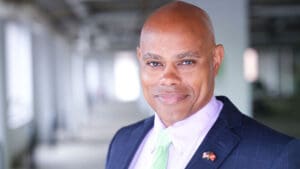Douglas Lemott Jr., a highly respected figure in the cybersecurity industry, currently serves as the Chief Information Security Officer (CISO) for the Analysis and Resilience Center for Systemic Risk (ARC).
With over three decades of experience in cybersecurity and IT, Douglas Lemott Jr. has established himself as a leader in developing secure and compliant technology solutions. Douglas Lemott Jr.’s career path has been shaped by his 27 years of service in the U.S. Marine Corps, where he oversaw the Marine Corps Cyberspace Operations Group. After retiring from military service, Lemott transitioned to high-profile roles in cybersecurity at SAP National Security Services (SAP NS2) and VMware. This interview delves into his background, the strategies he employs to foster innovation, and his insights into maintaining a balance between creativity and operational reliability.
Background and Career Path
Could you share what initially inspired your career path from the Marine Corps to cybersecurity, and how that journey has evolved over the years?
My career trajectory was significantly influenced by my time in the Marine Corps. There, I was exposed to the critical importance of network security and the defense of digital assets. The transition from military to civilian cybersecurity roles was a natural evolution of my passion for protecting essential information systems. At the heart of both roles is the mission to secure data and infrastructure, be it for national security or corporate integrity. Over the years, I’ve embraced the complexity of cybersecurity across different sectors, constantly adapting military discipline and strategic thinking to new environments.
Leadership Style and Innovation
In your leadership roles, especially at ARC, how do you maintain a balance between encouraging innovation and ensuring compliance and security?
Striking a balance between innovation and compliance is crucial, especially in high-stakes environments like finance or national infrastructure. I emphasize a culture of ‘controlled adaptability’ where creative experimentation is structured within defined risk parameters. This involves creating frameworks that allow innovation to flourish without compromising on compliance or operational reliability. Techniques such as sandboxes, pilot environments, and change management processes ensure that new ideas are rigorously tested and aligned with mission goals before implementation.
Cultivating Creativity within Structure
How do you encourage your team to innovate while operating within the strictures of military and corporate environments?
The key is to foster a culture where structure and creativity complement rather than conflict with each other. I draw from Marine Corps values like honor, courage, and commitment to instill a disciplined approach to innovation. This means creating environments where transparency and trust are paramount, allowing team members to freely contribute unconventional ideas. By integrating structured innovation sessions and encouraging dissenting opinions, we convert discipline into a foundation for creativity, proving that even the most structured settings can foster meaningful change.
Encouraging Emerging Leaders
What strategies do you use to empower emerging leaders to take risks and propose unconventional ideas?
I focus on building an environment where psychological safety and accountability coexist. By promoting ‘bounded risk-taking,’ I empower teams to explore and challenge norms within clearly defined mission parameters and risk thresholds. Routine scenario planning and post-mortems are integral to this approach, as they facilitate learning from both successes and failures. It’s about enabling teams to not just follow the playbook, but to rewrite it when necessary—a crucial aspect of leadership at scale.
Operationalizing Innovation
At SAP NS2 and VMware, you led several transformational initiatives. Could you describe a particularly creative solution you developed?
One of the most creative solutions was the shift towards treating security as a business enabler rather than a hurdle. By integrating ‘compliance-as-code’ into our DevOps pipeline, we enabled developers to apply regulatory controls early in the development cycle. This approach not only improved our security posture but also accelerated time to market and enhanced audit readiness. It was a win-win for security and business alike.
Jr.’s insights and experiences highlight the dynamic interplay between structured discipline and creative innovation, underscoring the importance of leadership in navigating complex environments. His career serves as an exemplar for integrating military principles into civilian cybersecurity practices, fostering resilience, and enabling forward-thinking strategies in risk management.
Continuing our insightful conversation with Jr., we delve deeper into his expertise, achievements, and vision for the future. This second part of the interview highlights the innovative approaches Lemott has championed in cybersecurity operations and his strategic foresight for emerging challenges in the field.
Expertise and Achievements
In your extensive career, what do you consider to be your most significant achievement in the field of cybersecurity?
The most significant achievement, in my view, has been the transformation of security into a proactive business enabler rather than a reactive obstacle. At SAP NS2, we implemented a comprehensive ‘compliance-as-code’ strategy that integrated regulatory controls directly into the DevOps pipeline. This approach not only enhanced our security posture but also accelerated time to market by 30% and substantially improved audit readiness. This shift in perspective allowed us to merge security with business goals, demonstrating that robust security practices could drive, rather than hinder, business agility.
You’ve led major transformations at both SAP NS2 and VMware. Can you discuss a particularly creative solution you’ve developed that improved security, scalability, or efficiency?
Certainly. One of the most creative solutions we developed at VMware involved reimagining how we approach compliance across multiple business units with differing requirements. We moved from a traditional policing model to embedding compliance practices directly into our development processes. By treating these compliance requirements as code, we made them part of the fabric of our software development lifecycle. This not only ensured compliance but also improved security and operational efficiency across our cloud platforms.
Vision for the Future
What do you see as the biggest challenge in cybersecurity over the next decade, and how is ARC preparing to address it?
The biggest challenge ahead is the rapid evolution of threats in an increasingly interconnected world. As cyber threats become more sophisticated, our strategies must evolve at a similar pace. At ARC, we’re focused on fostering cross-sector collaboration to enhance systemic resilience. By leveraging shared intelligence and innovative technologies, we aim to anticipate and neutralize threats before they impact critical infrastructure. Our mission is to build a unified defense strategy that integrates insights across sectors to stay ahead of emerging threats.
How are you fostering innovation at ARC to tackle these future challenges?
Innovation at ARC is driven by a culture of continuous improvement and collaboration. We are prototyping new capabilities that enhance our systemic risk response, though I must be discreet about specific projects due to sensitivities. Our approach involves creating an environment where experimentation is encouraged, but always within a framework that aligns with our mission and risk appetite. This includes developing pilot environments and robust change management processes to safely explore and implement new ideas.
Conclusion
Douglas Lemott Jr.’s leadership in cybersecurity exemplifies a forward-thinking approach to balancing innovation with operational reliability. By integrating military discipline with a progressive mindset, Lemott proves that structured environments can indeed foster substantial creativity and innovation. As cybersecurity landscapes continue to evolve, his strategic vision and dedication to fostering a resilient, collaborative defense posture are invaluable. Thank you, Douglas Lemott Jr. for sharing your insights and contributing to the ongoing advancement of cybersecurity practices.
Read more:
Douglas Lemott Jr. On A Journey from Marine Corps to Cybersecurity Leadership
















